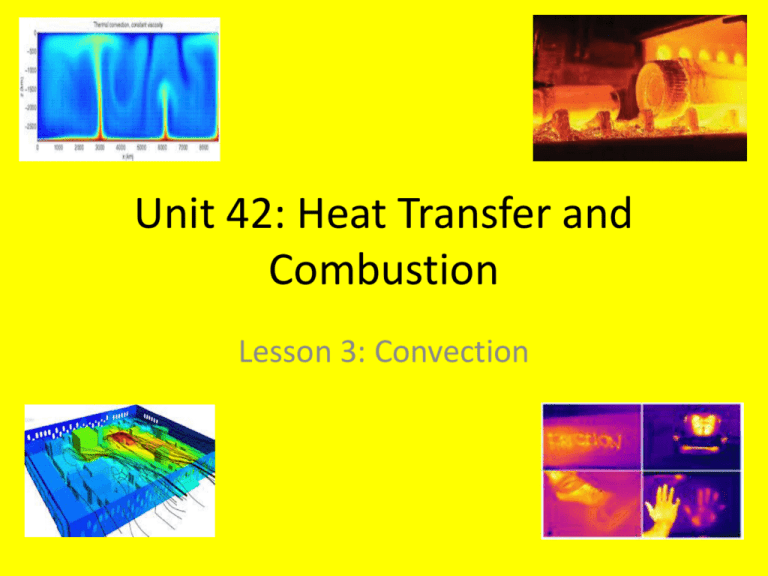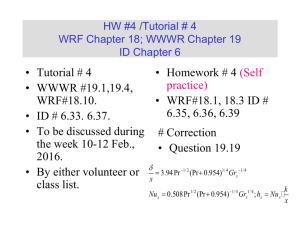File
advertisement

Unit 42: Heat Transfer and Combustion Lesson 3: Convection Aim NDGTA • LO1: Understanding Heat Transfer Rates for Composite Systems. Convection NDGTA • In order to consider heat transfer from fluids to solids and visa versa, rather than just between solids, we need to understand how heat is transferred by convection Nature of Convection NDGTA • Heat transfer by convection consists of two mechanisms. • In addition to energy transfer by random molecular motion (diffusion) there is also energy being transferred by the bulk motion of the fluid. • Thus in the presence of a temperature gradient, large numbers of molecules are moving together in bulk at the same time as the random motion off the individual molecules takes place. • The cumulative effect of both these energy transfer methods is referred to as heat transfer by convection. Heat Transfer by Convection NDGTA Hot Particles Cold Particles Heat flow to Particles Hot Surface Nature of Convection NDGTA • In engineering we are especially interested in heat transfer by convection that occurs between a fluid in motion and a solid boundary surface. • At the fluid-surface interface there is a region where the velocity of the fluid varies from zero at the surface to some infinite value u associated with the flow velocity. • This region of fluid is known as the velocity boundary layer Heat Transfer by Convection NDGTA Variation of velocity with distance from a solid boundary Y y Sold Boundary Velocity, u Nature of Convection Velocity boundary layer between fluid 1 and solid Tf1 NDGTA Velocity boundary layer between solid and fluid 2 Ts1 Solid Material Bulk fluid at temperature T1 Bulk fluid at temperature T2 Ts2 Tf2 Temperatures at solid surface B1 Thermal boundary layer between fluid 1 and solid B2 Thermal boundary layer between solid and fluid 2 B1 & B2 are the upper boundaries of the velocity boundary layers Nature of Convection NDGTA • If the surface of the fluid flow temperatures differ there is also a region of the fluid through which the temperature varies from Ts at the solid surface to Tf in the flow, as the heat energy is transferred. • This region is called the thermal boundary layer Nature of Convection NDGTA • It is important to note that at the surface where the bulk velocity is zero, all heat energy is transferred by random molecular motion i.e. by conduction. • As we move further away from the surface the boundary layer grows and heat transfer is more and more dependent on the contribution made by the bulk fluid motion. Nature of Convection NDGTA • Convection heat transfer may be classified according to the nature of the flow. – When the fluid flow is caused by external means we refer to heat transfer as forced convection e.g. consider the use of a fan to provide forced convection air cooling of electrical components in a PC. – Natural convection is induced by forces that result from density differences caused by temperature variations within a fluid. Nature of Convection NDGTA • Consider an electrical circuit board: air makes contact with the hot electrical components and experiences an increase in temperature. This causes a reduction in density. In this lighter air buoyancy forces causes vertical motion and the warm air rises. As this happens so it is replaced by an inflow of cooler ambient air – these convection currents now act as the heat transfer mechanism. Nature of Convection NDGTA • Regardless of the heat transfer process, the rate of heat transfer that is of particular interest to engineers may be determined by using Newton’s law of cooling given by the equation… . Q = hA(Ts – Tf) Where h is called the surface heat transfer coefficient (W/m2K) Heat Transfer with Convection through Composite Walls NDGTA • If the materials of the composite wall involve heat transfer from fluids to solids and visa versa rather than just between solids, then there is a similar electrical analogy to that for heat transfer by conduction between solids. • The surface heat transfer coefficient h depends on both the type of fluid and the fluid velocity. Heat Transfer with Convection through Composite Walls NDGTA • The thermal resistance of a fluid at the interface with a solid can be shown to be… Fluid thermal resistance, R = 1/hA Note the similarity to thermal resistance for conduction R = x/kA, both have the same units K/W. • The following example shows how we combine heat transfer by conduction though solids and heat transfer by conduction at the solid-fluid interface… Heat Transfer with Convection through Composite Walls NDGTA • The wall of a house consists of an inner thermal block 125mm wide and a 125mm house brick separated by an air gap. The inner surface wall is at a temperature of 25oC and the outside air film temperature is 5oC. For simplicity no additional insulating material has been included in the construction. • Calculate the heat flux (the rate at which heat is lost per m2) of the wall surface when, the surface heat transfer coefficient from the outside wall to air is 5 W/m2.K and the resistance to heat flow of the air gap is 0.15 k/W and the thermal conductivities of thermal block and outer brick are 0.2 and 0.5 W/m.K respectively. Composite Walls NDGTA T0=25oC T1 T2 T3 Thermal Brick . Heat flow Q Air Gap House Brick T4= 5oC Outside air layer . . Q Q R1 R2 R3 R4 Heat Transfer with Convection through Composite Walls NDGTA R = x/kA Considering unit Area R =x/k RTB = 0.125/0.2 = 0.625 K/W RHB = 0.125/0.5 = 0.25 K/W Rair gap = 0.15 K/W Rwall/air = 1/hA = 1/5 = 0.2 K/W RT = RTH + RAG + RHB + Rwall/Air = 0.625 + 0.15 + 0.25 + 0.2 = 1.225 K/W Heat Transfer with Convection through Composite Walls NDGTA • Using . equation… Q = (T0 – T4)/ RT We find the heat flux (heat loss per square metre to be… q = (25 – 5) / 1.225 = 16.3 W Suppose we want to find the interface temperature t1, then 16.3 = (25 – t1)/0.625 thus t1 = 14.8oC Heat Transfer through Cylindrical Walls Q dr r2 . t r 2 1 t1 . Unit length l = 1 NDGTA . Heat Transfer through Cylindrical Walls NDGTA Q = -kAdt/dr In this case A = 2πr (this assumes length l = 1) . So Q = -k2πrdt/dr Note: for a plane wall the area perpendicular to the heat flow is constant, but this is not the case for a cylindrical wall Heat Transfer with Convection through Composite Walls NDGTA • For a plane wall the area perpendicular to the heat flow is constant, but this is not the case for a cylinder wall. • At any radius within the cylinder, assuming negligible axial and circumferential heat transfer… . Q = -k2πrldt/dr (or –k2πrdt/dr for unit length) Heat Transfer with Convection through Composite Walls NDGTA • Thus… . Qdr/k2πr = -dt • Integrating between r2 and r1 gives… . t2 r2 Q/(2πk) dr/r = - dt . r1 t1 Thus Q ln r2 = - (t2 – t1) 2πk r1 Heat Transfer with Convection through Composite Walls NDGTA • Thus the heat transfer per unit length radially outwards is given by… . Q = 2πk(t1 – t2)/ln(r2/r1) Again considering the electrical analogue (I=V/r and t1 – t2 = V then the thermal resistance per unit length for a cylinder wall is… R = ln(r2/r1)/2πk (Verify this relationship!) Heat Transfer with Convection through Composite Walls NDGTA A steel pipe carrying steam at 250oC has an internal diameter of 100mm and an outside diameter of 120mm. The pipe is insulated using an inner layer of specially treated plastic based composite 40mm thick and an outer layer of felt 50mm thick. The ambient temperature surrounding the pipe is 20oC. Calculate the overall thermal resistance of the assembly and so find the heat loss per unit length of pipe. Also calculate the temperature on the outer surface of the pipe assembly. Assume that the heat transfer rates for internal and external surfaces of the pipe assembly are 500 and 15 W/m2K and the thermal conductivities of the steel, plastic composite and felt are 45, 0.2 and 0.05 W/mK respectively Heat Transfer with Convection through Composite Walls NDGTA 150mm Plastic composite 100mm Steel pipe . . T3 Felt T2 . . steam 60mm T1 T0 50mm Heat Transfer with Convection through Composite Walls NDGTA Considering unit length of pipe…then the thermal resistance of the steam film… R = 1/hA = 1/(500)(2π x 0.05) = 0.00637 K.W The thermal resistance of the steel pipe… R = ln(r2/r1)/2πk = Ln (60/50)/(2π)(45) = 0.000645K/W The thermal resistance of the plastic composite.. R = ln(r2/r1)/2πk = Ln (100/60)/(2π)(0.2) = 0.406K/W The thermal resistance of the felt… R = ln(r2/r1)/2πk = Ln (150/100)/(2π)(0.05) = 1.29K/W The thermal resistance of air… R = 1/hA = 1/(15)(2π x 0.15) = 0.0707 K.W Heat Transfer with Convection through Composite Walls NDGTA Thus total thermal resistance is… RT = 0.00637 + 0.000645 + 0.406 + 1.29 + 0.0707 Thus RT = 1.774 K/W Thus the heat loss per unit length… Q = (t0 – t4) /1.774 = (250-20)/1.774 = 1.297 W The temperature on the outer surface of the pipe… 129.7 = (t3 – t4)/0.071 = (t3 – 20)/ 0.071 = 29.2oC Heat Transfer with Convection through Composite Walls NDGTA • Note the insignificant amount of thermal resistance provided by the steel pipe. For this reason, to a first approximation, the thermal resistance of metal pipes is often ignored in these calculations. • Imagine the energy losses if the pipe were not lagged!






